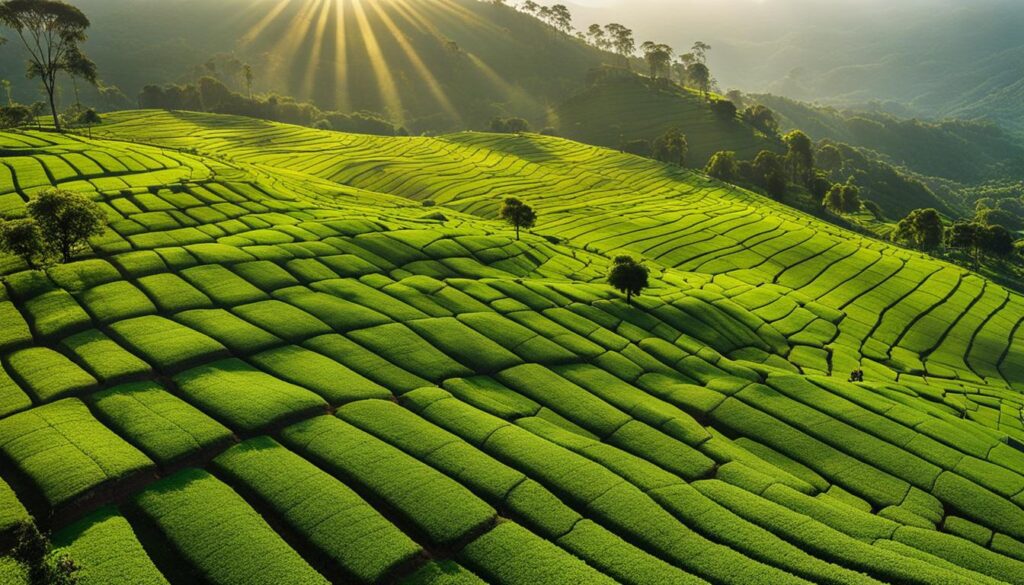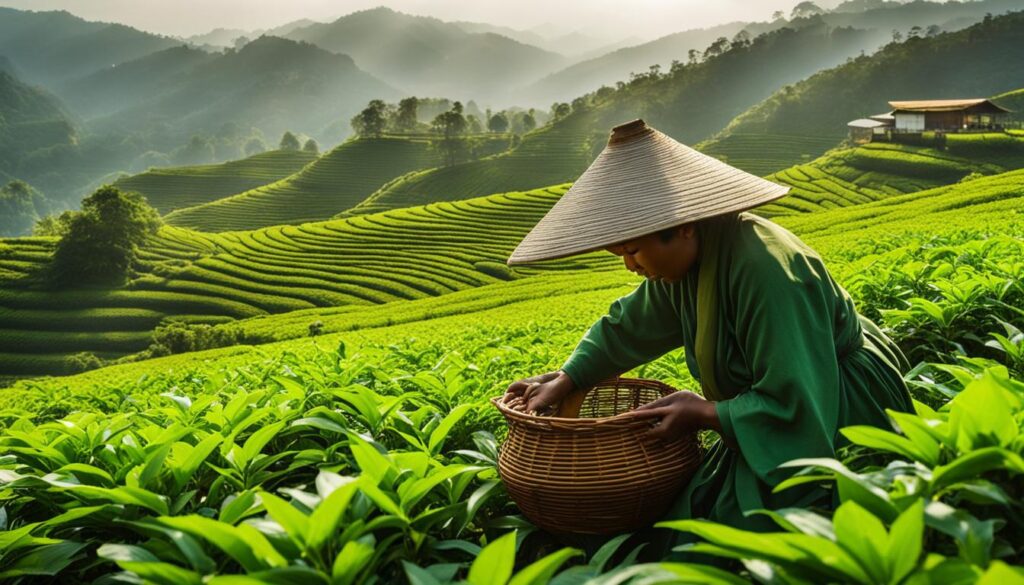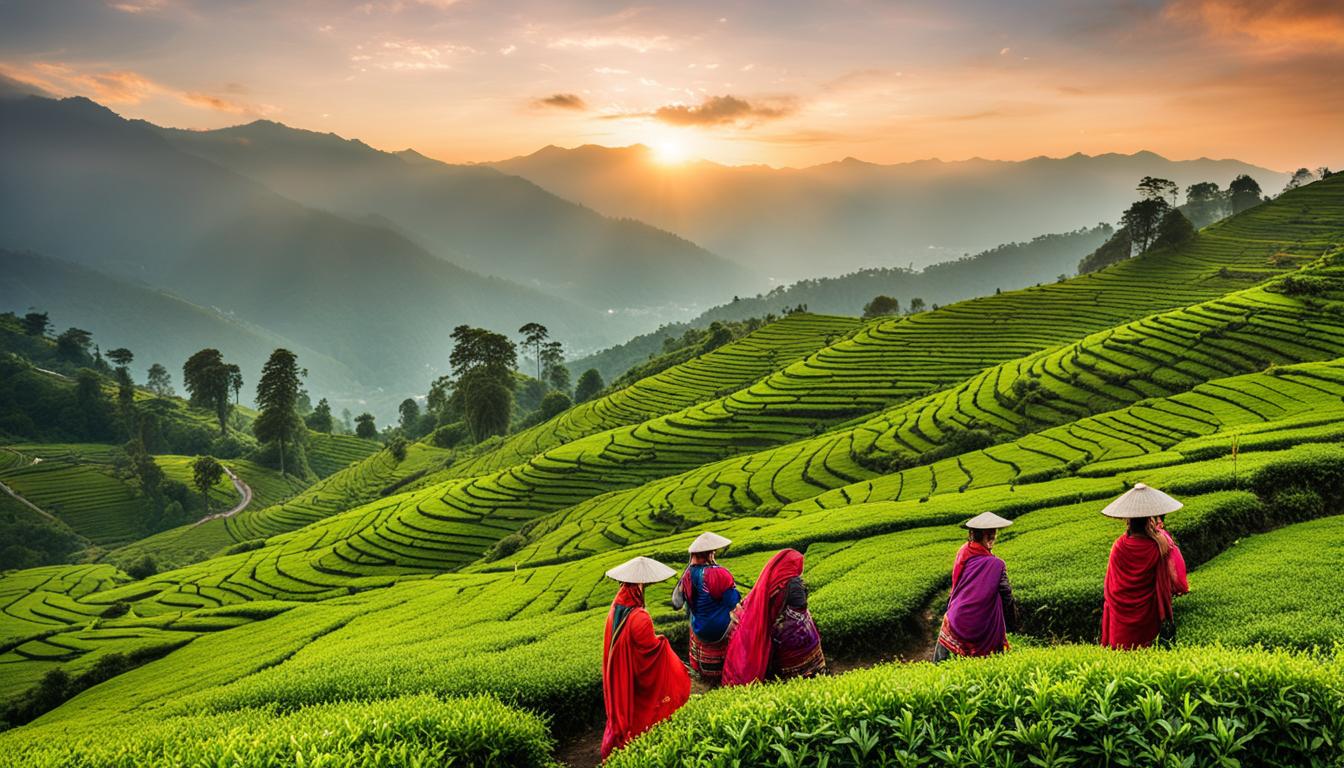Tea has a rich history that spans thousands of years, with China being the birthplace of the tea plant and the origin of tea culture. Today, the global tea market is valued at approximately $207.1 billion and is expected to reach $266.7 billion by 2025. China, India, Sri Lanka, and Kenya are the major tea-producing countries, each offering unique tea varieties, cultivation techniques, and cultural practices associated with tea.
Tea tourism provides an incredible opportunity for travelers to explore these major tea-producing countries, visit tea estates, and immerse themselves in the flavors and traditions of tea. Whether you’re sipping tea in a tranquil Chinese tea garden, witnessing the tea-making process in an Indian tea estate, or indulging in the diverse flavors of Ceylon tea in Sri Lanka, tea tourism allows you to experience the art and beauty of tea culture through travel.
Key Takeaways:
- Tea tourism offers the chance to explore major tea-producing countries like China, India, Sri Lanka, and Kenya.
- Each country has its own unique tea varieties, cultivation techniques, and cultural practices associated with tea.
- Tea tourism allows travelers to visit tea estates, experience tea culture firsthand, and immerse themselves in the flavors and traditions of tea.
- The global tea market is valued at approximately $207.1 billion and is expected to reach $266.7 billion by 2025.
- Tea tourism presents a valuable opportunity for tea enthusiasts and travelers looking for unique and immersive experiences.
Tea Tourism in China: Exploring the Birthplace of Tea
China, the birthplace of tea, offers a remarkable tea tourism experience that allows visitors to immerse themselves in the rich Chinese tea culture. Known for its diverse tea varieties and deep-rooted tea traditions, China is a must-visit destination for tea enthusiasts. From the lush green tea plantations in Fujian and Zhejiang to the ancient tea mountains of Yunnan, there are numerous tea tourism destinations in China waiting to be explored.
Chinese tea culture is steeped in history and symbolism. Tea is not just a beverage; it is a way of life. The art of making and serving tea has been perfected over centuries, and participating in a traditional Chinese tea ceremony is an unforgettable experience. It is a moment to slow down, savor the flavors, and appreciate the beauty of tea.
The Chinese tea plantations are home to famous tea varieties that have gained international recognition. From the delicate and aromatic Longjing (Dragon Well) green tea to the highly prized Pu-erh tea, each variety has its unique characteristics and flavors. Exploring the tea plantations in China provides a firsthand opportunity to witness the tea-making process, from plucking the leaves to the intricate steps of tea processing.
| Chinese Tea Varieties | Flavor | Region |
|---|---|---|
| Longjing (Dragon Well) Green Tea | Delicate, sweet, nutty | Zhejiang |
| Jasmine Tea | Fragrant, floral | Fujian |
| Da Hong Pao (Big Red Robe) Oolong Tea | Rich, roasted, complex | Fujian |
| Tie Guan Yin (Iron Goddess) Oolong Tea | Floral, orchid-like | Fujian |
Whether you choose to wander through the tea fields, learn from the tea masters, or simply indulge in a cup of tea at a local teahouse, tea tourism in China promises an enriching and enlightening experience for tea lovers worldwide.
Tea Tourism in India: Unveiling the World of Indian Tea
India, with its diverse tea regions, rich tea culture, and famous tea varieties, offers a captivating tea tourism experience. From the robust and full-bodied Assam teas to the delicate and aromatic Darjeeling teas, each region in India showcases its unique flavors and traditions. Exploring the world of Indian tea through tea tourism allows visitors to not only witness the tea-making process but also immerse themselves in the vibrant Indian tea culture.

The famous tea regions of India, such as Assam and Darjeeling, are a treat for tea enthusiasts. Assam, located in northeastern India, is known for its strong and malty black teas. With sprawling tea estates, visitors can witness the tea plucking process and learn about the intricacies of tea production. Darjeeling, nestled in the foothills of the Himalayas, produces the renowned muscatel-flavored tea. Tea tourists can enjoy breathtaking views of the tea gardens while savoring the delicate flavors of Darjeeling tea.
Other tea regions in India, including Nilgiri, Dooars, Kangra, Munnar, Sikkim, and Meghalaya, offer their own distinct tea experiences. Each region has its unique terroir, climate, and tea-growing practices, resulting in teas with distinct characteristics. Tea tourism in these regions allows visitors to explore tea estates, interact with local tea farmers, and learn about the traditional brewing techniques that have been passed down through generations.
Table: Famous Indian Tea Regions
| Region | Famous Tea Varieties |
|---|---|
| Assam | Assam Black Tea |
| Darjeeling | Darjeeling Black Tea, Darjeeling Green Tea |
| Nilgiri | Nilgiri Black Tea, Nilgiri Green Tea |
| Dooars | Dooars Black Tea |
| Kangra | Kangra Black Tea, Kangra Green Tea |
| Munnar | Munnar Black Tea, Munnar Green Tea |
| Sikkim | Sikkim Black Tea, Sikkim Green Tea |
| Meghalaya | Meghalaya Black Tea |
Tea tourism in India provides a unique opportunity to learn about the deep-rooted history and cultural significance of tea in the country. Indian tea culture is woven into the fabric of everyday life, with tea being an integral part of social gatherings, celebrations, and daily rituals. Through tea tastings, tea ceremonies, and interactions with tea experts, visitors can gain a deeper appreciation for the art of tea and the passion of the tea producers.
Embarking on a tea tourism journey in India not only allows travelers to explore the beautiful tea regions but also supports the local communities and sustainable tea farming practices. It is a chance to connect with nature, indulge in authentic tea experiences, and create lifelong memories in the mesmerizing world of Indian tea.
Tea Tourism in Sri Lanka: Delving into the World of Ceylon Tea
Sri Lanka, also known as Ceylon, offers a unique tea tourism experience that allows visitors to delve into the world of Ceylon tea. With its lush tea plantations, rich tea culture, and diverse tea flavors, Sri Lanka is a must-visit destination for tea enthusiasts and travelers seeking an immersive experience. The country’s tea industry traces its roots back to the 19th century when the region’s coffee plantations were devastated by a fungus. Since then, tea has become an integral part of Sri Lankan culture and a significant contributor to the country’s economy.
Tea plantations in Sri Lanka are spread across various regions, each offering its own distinct tea flavors. Nuwara Eliya, located in the central highlands, is known for its high-altitude teas with floral and delicate flavors. On the other hand, Uva, situated in the southeastern region, produces teas with robust and malty profiles. The scenic beauty of these tea regions adds to the charm of tea tourism in Sri Lanka, attracting visitors with breathtaking landscapes and serene environments.
During a tea tourism experience in Sri Lanka, visitors can explore the tea estates, witness the tea harvesting process, and participate in tea tastings. These activities provide insights into the art and skill behind tea production, allowing travelers to appreciate the craftsmanship involved in producing a perfect cup of Ceylon tea. Whether wandering through the vibrant green tea gardens or savoring the flavors of different tea varieties, tea enthusiasts will find themselves immersed in the world of Ceylon tea, surrounded by the sights, sounds, and aromas that make Sri Lanka a tea lover’s paradise.

Table: Tea Varieties in Sri Lanka
| Tea Region | Tea Varieties |
|---|---|
| Nuwara Eliya | High-altitude teas with floral and delicate flavors |
| Uva | Teas with robust and malty profiles |
| Kandy | Versatile teas suitable for both black and green tea production |
“Tea tourism in Sri Lanka offers a sensory journey into the world of Ceylon tea, allowing visitors to explore the tea estates, learn about the tea-making process, and indulge in the flavors of this renowned beverage. The picturesque landscapes and welcoming tea communities make Sri Lanka an ideal destination for tea enthusiasts looking to deepen their appreciation and knowledge of tea.”
Tea tourism in Sri Lanka provides a unique opportunity to experience the thriving Ceylon tea culture and immerse oneself in the traditions and flavors that define this remarkable beverage. With its breathtaking plantations, diverse tea varieties, and warm hospitality, Sri Lanka invites tea lovers from around the world to embark on a tea-centric adventure that will leave them with a deeper understanding and appreciation for the art of tea production.
Conclusion
Tea tourism is a captivating trend that offers a delightful way to explore the world of tea and immerse yourself in its rich history, diverse cultures, and enchanting flavors. Whether you are a tea enthusiast or simply an avid traveler seeking unique experiences, tea tourism provides an opportunity to embark on exciting adventures in renowned tea regions across the globe.
Major tea-producing countries like China, India, Sri Lanka, and Kenya beckon with their own distinct tea varieties and fascinating tea traditions. From exploring the birthplace of tea in China to unveiling the world of Indian tea, and delving into the treasures of Ceylon tea in Sri Lanka, each destination offers a remarkable journey of tea discovery.
Tea farm tours worldwide allow you to step into the shoes of tea farmers, witness the meticulous tea production process, and savor the exquisite flavors of freshly brewed tea. Engage with local tea communities, participate in tea tastings and ceremonies, and gain a deeper appreciation for the art and skill behind tea cultivation.
With the global tea market continuing to expand, tea farming tourism opportunities are on the rise. So, whether you’re sipping tea on a misty mountain slope or strolling through picturesque tea gardens, tea tourism promises an unforgettable experience that connects you with the origins of your favorite brew and leaves you with a newfound love for the world of tea.
FAQ
What is tea tourism?
Tea tourism refers to the travel and exploration of major tea-producing countries, where visitors can immerse themselves in tea culture, visit tea estates, learn about tea production, and participate in tea tastings and ceremonies.
Which are the major tea-producing countries for tea tourism?
The major tea-producing countries for tea tourism are China, India, Sri Lanka, and Kenya.
What can I expect from tea tourism in China?
In China, you can expect to explore the birthplace of tea, visit tea plantations, learn about Chinese tea culture, and experience famous Chinese tea varieties like green tea, white tea, jasmine-scented tea, and Oolong tea.
What can I experience during tea tourism in India?
During tea tourism in India, you can unveil the world of Indian tea, visit tea estates, witness the tea-making process, and enjoy famous Indian tea regions like Assam and Darjeeling, known for their unique flavors.
What does tea tourism in Sri Lanka offer?
Tea tourism in Sri Lanka allows you to delve into the world of Ceylon tea, visit tea plantations, learn about the tea industry’s history, and sample the diverse flavors of high-altitude teas from regions like Nuwara Eliya and Uva.
How can tea tourism connect me with the origins of tea?
Tea tourism provides the opportunity to connect with the origins of tea by visiting tea estates, engaging with local tea farmers, witnessing the tea production process, and participating in tea tastings and ceremonies.





